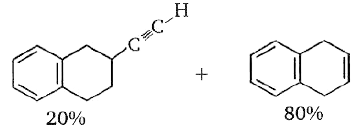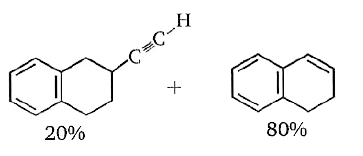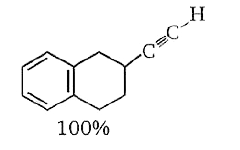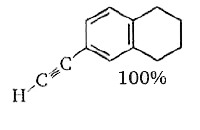What product would be obtained from the reaction of cyclopropane with Cl2 in the presence of FeCl3?
1,2-dichloropropane
1,2-dichlorocyclopropane
1,3-dichloropropane
1,1-dichlropropane
The correct Answer is:3
To determine the product obtained from the reaction of cyclopropane with Cl₂ in the presence of FeCl₃, we can follow these steps:
Step 1: Understand the Reactants
Cyclopropane (C₃H₆) is a three-membered carbon ring. It is known for having significant ring strain due to its small bond angles (approximately 60 degrees) compared to the ideal tetrahedral angle of 109.5 degrees in sp³ hybridized carbons.
Step 2: Identify the Role of FeCl₃
FeCl₃ acts as a Lewis acid and helps generate a chlorine electrophile (Cl⁺) from Cl₂. The reaction can be represented as:
Cl2+FeCl3→Cl++FeCl−4
Step 3: Electrophilic Attack
The electrophilic chlorine (Cl⁺) will attack one of the carbons in the cyclopropane ring. Due to the ring strain, the cyclopropane is unstable, and the ring can open up upon attack by the electrophile.
Step 4: Ring Opening
When Cl⁺ attacks cyclopropane, it leads to the opening of the ring, resulting in a linear chain of three carbon atoms:
C3H6→CH+2CH2CH2
Step 5: Chlorination of the Open Chain
After the ring opens, the carbon chain can react further with another Cl atom from the Cl₂. The chlorine can attach to any of the terminal carbons of the now linear chain. The most stable product will have chlorine atoms on different carbons.
Step 6: Determine the Product Structure
The final product will be 1,3-dichloropropane, where chlorine atoms are attached to the first and third carbon atoms of the propane chain:
ClCH2CH2CH2Cl
Step 7: Write the IUPAC Name
The IUPAC name for the compound formed is 1,3-dichloropropane.
Final Answer
The product obtained from the reaction of cyclopropane with Cl₂ in the presence of FeCl₃ is 1,3-dichloropropane.
---
Cyclopropane (C₃H₆) is a three-membered carbon ring. It is known for having significant ring strain due to its small bond angles (approximately 60 degrees) compared to the ideal tetrahedral angle of 109.5 degrees in sp³ hybridized carbons.
FeCl₃ acts as a Lewis acid and helps generate a chlorine electrophile (Cl⁺) from Cl₂. The reaction can be represented as:
Cl2+FeCl3→Cl++FeCl−4
The electrophilic chlorine (Cl⁺) will attack one of the carbons in the cyclopropane ring. Due to the ring strain, the cyclopropane is unstable, and the ring can open up upon attack by the electrophile.
When Cl⁺ attacks cyclopropane, it leads to the opening of the ring, resulting in a linear chain of three carbon atoms:
C3H6→CH+2CH2CH2
After the ring opens, the carbon chain can react further with another Cl atom from the Cl₂. The chlorine can attach to any of the terminal carbons of the now linear chain. The most stable product will have chlorine atoms on different carbons.
The final product will be 1,3-dichloropropane, where chlorine atoms are attached to the first and third carbon atoms of the propane chain:
ClCH2CH2CH2Cl
The IUPAC name for the compound formed is 1,3-dichloropropane.
The product obtained from the reaction of cyclopropane with Cl₂ in the presence of FeCl₃ is 1,3-dichloropropane.
Topper's Solved these Questions
- HYDROCARBONSBOOK - AAKASH INSTITUTE ENGLISHCHAPTER - HYDROCARBONSEXERCISE - Try yourself
78 Videos
- HYDROCARBONSBOOK - AAKASH INSTITUTE ENGLISHCHAPTER - HYDROCARBONSEXERCISE - Exercise
33 Videos
- HYDROCARBONSBOOK - AAKASH INSTITUTE ENGLISHCHAPTER - HYDROCARBONSEXERCISE - SECTION-I SUBJECTIVE QUESTIONS
9 Videos
- HALOALKANES AND HALOARENES BOOK - AAKASH INSTITUTE ENGLISHCHAPTER - HALOALKANES AND HALOARENES EXERCISE - ASSIGNMENT SECTION -D
15 Videos
- HYDROGENBOOK - AAKASH INSTITUTE ENGLISHCHAPTER - HYDROGENEXERCISE - ASSIGNMENT (SECTION - D) (Assertion-Reason Type question)
15 Videos
Similar Questions
Knowledge Check
The reaction of toluene with Cl2 in presence of FeCl3 gives :
Abenzoyl chlorideBbenzyl chlorideCo - and p - chlorotolueneDm-chlorotolueneWhat are the products obtained from the following reaction?
 A
A B
B C
C D
D
What product would be formed from the SN2 reaction of(S)-3-chlorohexane and hydroxide ion ?
A2-butanolB(S) =-2-butanolC(R) -3-hexanolD3-pentanol
What would be the products of the given reaction ?

View SolutionThe major product obtained from the following reaction is :

View SolutionWhat would be the product fromed in given reaction
_CHE_E06_198_Q01.png)
View SolutionWhat is the product obtained in the following reaction

View SolutionWhat product will be formed on reaction of propanal with 2-methylpropanal in the presence of NaOH? Write the name of the reaction also.
View Solution


